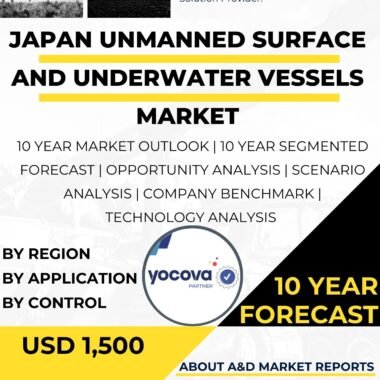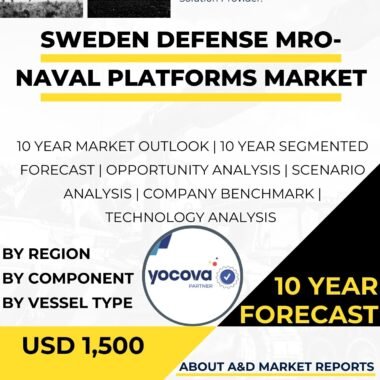Description
The China unmanned surface and underwater vessels market has witnessed significant growth and development in recent years. With China’s focus on enhancing its maritime capabilities, improving surveillance and reconnaissance, and expanding its unmanned systems technologies, there has been a substantial demand for advanced unmanned vessels. This market analysis provides an overview of the China unmanned surface and underwater vessels market, including key players, market drivers, challenges, and future prospects.
The China unmanned surface and underwater vessels market is characterized by the presence of both domestic and international players. Domestic companies, such as China Shipbuilding Industry Corporation (CSIC), China State Shipbuilding Corporation (CSSC), and Oceanalpha Co., Ltd., have made significant contributions to the development, production, and supply of unmanned vessels. These companies have invested in research and development to enhance the capabilities of their vessels and meet the specific requirements of the Chinese maritime industry.
International players, including renowned defense technology manufacturers such as General Dynamics Corporation, Lockheed Martin Corporation, and Kongsberg Gruppen, have also established collaborations and partnerships in China. These partnerships have facilitated technology transfer, knowledge exchange, and joint development programs, contributing to the advancement of unmanned vessel capabilities in China.
One of the primary drivers is China’s focus on enhancing its maritime capabilities and improving surveillance and reconnaissance. Unmanned surface and underwater vessels play a crucial role in augmenting the capabilities of maritime forces, providing persistent surveillance, and conducting intelligence gathering missions. As China seeks to expand its maritime presence, improve its situational awareness, and enhance its overall maritime security, the demand for advanced unmanned vessels has grown.
Furthermore, the need for reducing risks to personnel and increasing operational efficiency has fueled the demand for unmanned vessels in China. Unmanned vessels can be employed in various maritime operations, including surveillance, mine detection, and underwater inspections. By utilizing unmanned surface and underwater vessels, China can significantly reduce the risks faced by personnel and enhance operational safety. As China aims to protect its maritime assets, improve operational efficiency, and leverage the advantages of unmanned systems, the demand for unmanned vessels has increased.
Technological advancements have played a crucial role in the growth of the China unmanned surface and underwater vessels market. Domestic companies have focused on developing indigenous unmanned vessels with improved autonomy, endurance, payload capacity, and sensor capabilities. China has made significant progress in the development of various unmanned vessels, including autonomous surface vessels (ASVs), unmanned underwater vehicles (UUVs), and hybrid vessels.
China has successfully developed and deployed advanced unmanned vessels, such as the CSIC SeaFly-01 ASV, which provides surveillance and reconnaissance capabilities for maritime operations. The development of UUVs, such as the CSSC SeaDragon, has enhanced China’s capabilities in underwater inspections and mine detection. Additionally, hybrid vessels, which combine both surface and underwater capabilities, have been developed to perform a wide range of missions, including surveillance, environmental monitoring, and underwater exploration.
Another driver of the China unmanned surface and underwater vessels market is the civilian sector, including applications in fields such as maritime research, environmental monitoring, and offshore industry support. Unmanned vessels have found applications in marine research, environmental surveys, and offshore inspections. China’s growing interest in unmanned systems and its focus on marine conservation and sustainable development has created a demand for unmanned vessels in non-military applications. The development of unmanned vessels for civilian use provides opportunities for technology transfer and commercialization, further driving the growth of the market in China.
However, the China unmanned surface and underwater vessels market also face certain challenges. One of the primary challenges is the need for continuous investment in research and development to stay ahead of evolving technologies, emerging operational requirements, and changing maritime environments. As adversaries develop more advanced countermeasures and seek to neutralize unmanned vessels, China must invest in innovation and advanced technologies to maintain its unmanned vessel capabilities.
Additionally, the market faces challenges related to international export restrictions and arms control regulations. The development and export of unmanned vessels are subject to strict regulations due to security concerns and international agreements. This can limit market opportunities and hinder collaboration with international partners.
Looking ahead, the future prospects for the China unmanned surface and underwater vessels market are promising. China’s commitment to maritime security, operational efficiency, and technological advancement will continue to drive investments in unmanned vessels. Ongoing research and development efforts, collaborations between domestic companies and international partners, and the integration of emerging technologies, such as artificial intelligence, advanced sensors, and autonomous capabilities, are expected to result in the introduction of more advanced and capable unmanned vessels.
The integration of artificial intelligence and advanced sensor systems may shape the future of the market. Artificial intelligence algorithms can enhance the autonomy and decision-making capabilities of unmanned vessels, enabling them to adapt to dynamic maritime conditions. Advanced sensor systems, including sonar, LiDAR, and radar, can improve situational awareness, object detection, and environmental monitoring capabilities for unmanned vessels, enhancing their operational effectiveness.
In conclusion, the China unmanned surface and underwater vessels market has witnessed significant growth driven by the country’s focus on maritime security, surveillance and reconnaissance capabilities, and advancing unmanned systems technologies. Technological advancements, collaborations between domestic and international players, and the government’s commitment to indigenous defense capabilities have contributed to the development and deployment of advanced unmanned vessels. Challenges related to evolving technologies, export restrictions, and arms control need to be addressed. With ongoing research and development, collaborations, and the integration of emerging technologies, the future of the China unmanned surface and underwater vessels market looks promising, with opportunities for further growth, innovation, and advancements in unmanned vessel capabilities.




